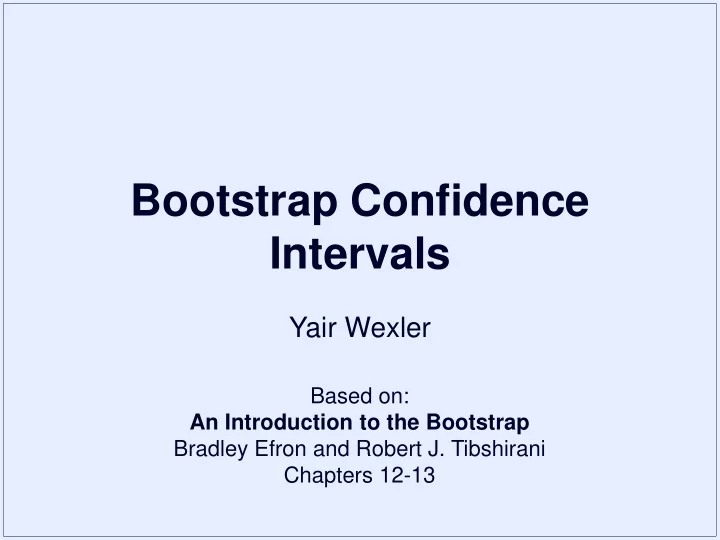

Bootstrap Confidence Intervals Yair Wexler Based on: An Introduction to the Bootstrap Bradley Efron and Robert J. Tibshirani Chapters 12-13
Introduction • Chapters 12 and 13 discuss approximate confidence intervals to some parameter . – Chapter 12 - Confidence intervals based on bootstrap “tables” • Bootstrap-t intervals – Chapter 13 - Confidence intervals based on bootstrap percentiles • Percentile intervals • Both chapters discuss one sample non-parametric bootstrap .
Bootstrap-t • Normal theory approximate confidence intervals are based on the distribution of approximate pivots : • The bootstrap-t method uses bootstrap sampling to estimate the distribution of the approximate pivot Z: – For and , a bootstrap-t interval is a Student-t interval.
Bootstrap-t • Suggested by Efron (1979) and revived by Hall (1988). • Creates an empirical distribution table from which we calculate the desired percentiles. • Doesn’t rely on normal theory assumptions. • Asymmetric interval (in general). • “ bootstrap ” R package – boott()
Bootstrap-t algorithm 1. Calculate from the sample x . 2. For each bootstrap replication b=1 ,…,B: Generate bootstrap sample x *b . 1. Using some measure of the standard error of x *b , calculate: 2. 3. The bootstrap- t “table” q th quantile is: 4. 100(1- α )% Bootstrap-t confidence interval for :
Bootstrap-t vs Normal theory • Improved accuracy : – Coverage tend to be closer to 100(1- α )% than in normal or t intervals. – Better captures the shape of the original distribution. Efron, 1995. Bootstrap Confidence Intervals. • Loss of generality : – Z table applies to all samples. – Student-t table applies to all samples of a fixed size n. – Bootstrap-t table is sample specific.
Bootstrap-t vs Normal theory • Example : – Confidence intervals to the expected value of . – Plug-in estimator for : – Plug-in estimator for standard error: – n=100:
Bootstrap-t vs Normal theory • Comparison of coverage: – n=15,100,5000
Issues regarding Bootstrap-t • Bootstrap estimation of where there is no formula: – B 2 replications for each original replication b=1 ,…,B. – Total number of bootstrap replications: B*B 2 . – Efron and Tibshirani suggest B=1000, B 2 =25 => total of 25,000 bootstrap replications. • Not invariant to transformations. – Change of scale can have drastic effects. – Some scales are better than others. • Applicable mostly to location statistics .
Bootstrap-t and transformations • Example: Fisher-z transformation Fisher 1921 – If ( X,Y ) has a bivariate normal distribution with correlation ρ . – An approximate normal CI for : – Apply the reverse transformation for an approximate CI for ρ .
Bootstrap-t and transformations • Simulation results for bootstrap-t with n=15: – Red : 95% CI bootstrap-t interval for r directly. ( 96% coverage, 33% outside valid range ) – Blue : 95% CI bootstrap-t interval using Fisher transformation. (93% coverage, 0% outside valid range) True value Valid range
Bootstrap-t and transformations • Variance stabilization and normalization of the estimate:
Variance stabilization • In general, it is impossible to achieve both variance stabilization and normalization. – Bootstrap-t works better for variance stabilized parameters. – Normality is less important. • In general, the variance stabilizing transformation is unknown. – Requires estimation.
Variance stabilization • Tibshirani (1988) suggests a method to estimate the variance-stabilizing transformation using bootstrap: – Transformation is estimated using B 1 replications. • Each replication requires B 2 replications to estimate the standard error . – Bootstrap-t interval is calculated using new B 3 replications. • Efron and Tibshirani suggest B 1 =100, B 2 =25 and B 3 =1000 (total B 1 B 2 +B 3 =3500). • “bootstrap” package: – boott (…, VS = TRUE ,…)
Bootstrap-t with variance stabilization 1. Generate B 1 bootstrap samples x *1 ,…,x *B1 . For each bootstrap replication b=1 ,…,B 1 : 1. Calculate . Generate B 2 bootstrap samples x **b to estimate . 2. 2. Smooth as a function of . 3. Estimate the variance stabilizing transformation . 4. Generate B 3 bootstrap samples. 1. Compute a bootstrap-t interval for . 2. Standard error is (roughly) constant => 5. Perform reverse transformation.
Confidence intervals based on bootstrap percentiles
The percentile interval • The bootstrap-t method estimates the distribution of an approximate pivot : • The percentile interval (Efron 1982) is based on calculating the CDF of the bootstrap replications . – A 100(1- α )% percentile interval is:
The percentile interval • The percentile interval has 2 major assets: – Invariance to monotone transformation . • For any monotone transformation • No knowledge of an appropriate transformation is required. – Range preservation . • and obey the same restrictions on the values of . • The percentile interval will always fall in the allowable range.
Invariance to transformation • Example: a percentile interval for the ρ =corr(X,Y), using the distribution of directly (left), and the distribution of (Fisher transformation, right)
Issues with percentile intervals • Doesn’t cope with biased estimators. • Tendency for under-coverage in small samples. • Both issues are present in bootstrap-t and normal theory intervals.
Comparison of bootstrap confidence intervals • Comparison of coverage for the correlation example, with n=15,100,5000 .
Recommend
More recommend